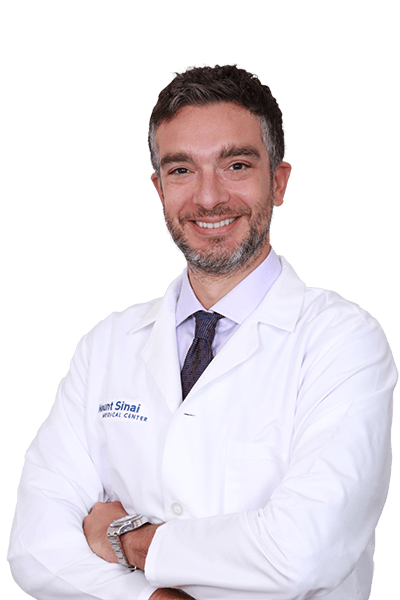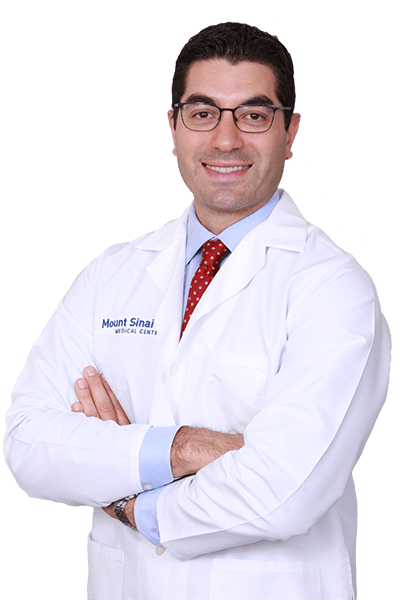Hip & Knee
The hip and the knee are among the largest joints in the body. At the Division of Orthopedics at Mount Sinai, our highly trained surgeons perform the most technologically advanced procedures using minimally invasive surgical techniques, including the new anterior hip replacement approach, as well as the use of robotics. This translates into less postoperative pain, lower risk of complications, and a quicker recovery.
Injury, Trauma, & Overuse Conditions
Injuries from household accidents, sports, trauma, and overuse cause many problems that can be treated by the Mount Sinai orthopedic team.
When it comes to treating orthopedic injuries of the hip and knee, our team uses advanced diagnostic tools, including powerful MRI, to see microscopic tears in tendons (which connect muscles to bone) and damage to ligaments (which connect bones to bones), as well as tiny fractures to bones. These diagnostic imaging tools allow the Mount Sinai team to choose the most appropriate treatment approach, which may include:
- Hard casts to immobilize the injured bones
- Slings or braces to minimize movement and strain
- Physical therapy
- Injections of steroids and other medicines to promote healing and reduce pain
- Minimally invasive arthroscopic surgery
- Surgery using metal plates and screws
- Tendon transfers and reconstruction
The physicians, technologists, and other providers on the Mount Sinai orthopedic team use these treatments in addition to other approaches for nearly every type of upper knee injury, including the following:
Hip Fracture
Older people frequently break their hips from a fall. We consider a broken hip a medical emergency that needs to be fixed within 24-48 hours to ensure the best results. Delaying care can negatively affect the results from treatment. If you or a loved one falls and may have a broken hip with symptoms like pain and an inability to bear weight, call 9-1-1, or go to the emergency room. Treatment for a broken hip usually requires surgery and extensive rehabilitation.Knee ACL Injuries
The ACL, or anterior cruciate ligament, connects the thigh bone to the shin bone. ACL injuries are one of the most common knee ligament injuries in athletes. They typically don’t result from an impact, but instead when the knee “buckles.” Patients often describe hearing or feeling a “pop,” and then the knee becomes swollen and painful. At Mount Sinai, we almost always treat torn ACLs with surgery to reconstruct the damaged ligament.Knee Cartilage Defects
Defects in isolated areas of cartilage in the knees can happen as a result of a traumatic event like a sports injury, or from repetitive movements that “grind” down the cartilage. We treat these isolated defects differently than whole-knee arthritis. Instead, these isolated defects can be treated with special cartilage restoration surgeries.Knee Collateral Ligament Injuries (LCL/MCL)
The MCL, or medial collateral ligament, is the most commonly injured ligament in the knee. The injury happens when the knee gets bent inward. An MCL injury can happen by itself or can happen along with an ACL injury. If only the MCL is injured, surgery is rarely required. Instead, we use a knee brace and physical therapy. Injuries to the LCL, or lateral collateral ligament, happen when the knee is bent outward, usually from a direct blow to the inside of the knee. An LCL injury is a serious condition that often happens with knee ligament injuries. When multiple ligaments get injured, we call it “multiligament knee injuries,” and usually have to perform surgery to fix the injury.Knee Meniscal Injuries
The meniscus are two C-shaped structures in the knee that act as shock absorbers. Meniscal injuries are common in younger patients from playing sports. In older patients, we see meniscal injuries as a result of “wear and tear” or degeneration. Patients often experience sharp pain and knee mechanical symptoms such as “locking” or “clicking,” especially with squatting. Traumatic meniscal injuries often require surgery to repair the meniscus or remove the torn piece. Degenerative meniscal tears may respond well without the need for surgery.Knee PCL Injuries
The PCL, or posterior cruciate ligament, connects the thigh bone to the shin bone behind the knee. Injuries to the PCL can happen from a direct blow to the knee or from a hyperextension injury. More severe injuries may occur with knee dislocations. Isolated PCL injuries can be treated without surgery with physical therapy and bracing.Labrum Tear
The labrum is a type of cartilage found in the hip joint. It helps keep the “ball” of the thigh bone centered and aligned with the hip “socket.” Sometimes the labrum can tear, causing groin pain and painful clicking in the front side of the hip joint. Most labrum injuries are due to sports injuries in young adults. Conditions such as hip dysplasia, femora-acetabular impingement, and other defects of the hip joint can also contribute to labrum tears. When the labrum tears, we often need to repair it with surgery.Patella Instability and Dislocations
The patella is often referred to as the “knee cap.” It can become dislocated from trauma like a sports injury, or a patient may have anatomy that increases their risk of patella instability. If someone’s patella dislocates many times, it requires surgery to stabilize the patella.Arthritis
Arthritis is a general term used to describe joint pain or joint damage. It can be caused by a wide range of conditions, including degeneration that increases with age, inflammation – sometimes from an auto-immune disease like rheumatoid arthritis – or various types of infection.
At Mount Sinai Medical Center, we treat nearly all forms of arthritis, including those that affect the hip and knee. Our specialists treat arthritis based on which joint or joints are affected. Many kinds of arthritis can be effectively controlled with anti-inflammatory medications, such as a non-steroidal anti-inflammatory like ibuprofen. Topical anti-inflammatory medications can also help. Our physicians also use steroid injections and physical therapy.
For more severe cases, joint replacement surgery can eliminate pain and help a patient gain their lost range of motion. Joint replacement is especially useful for larger joints like hips and knees. Mount Sinai’s orthopedic surgeons also use advanced surgeries like tendon grafts to reconstruct certain joints. Our interventions treat both hip and knee arthritis.
Orthopedic Defects & Deformities
Some patients are born with certain deformities. These cases are known as congenital, which means “from birth.” Other deformities can occur later in life as the result of injuries, disease, or overuse. They can also occur spontaneously without any easily identifiable cause. Mount Sinai’s team of orthopedic specialists provides treatments to address a variety of defects and deformities, including:
Bowlegs/Genu Varum
Bowlegs, or genu varum, means that the knees are pointing outward, giving the leg a “parenthesis” appearance. This can cause knee pain, meniscus tears, knee instability, early knee arthritis, and difficulty walking. Knee realignment surgery may help correct the deformity by preventing or delaying the onset of end-stage knee arthritis.Coxa Profunda
Coxa profunda means “deep socket.” It’s the opposite of hip dysplasia. In the case of coxa profunda, the ball of the thigh bones sits deep in the hip socket. It can lead to abnormal bone growth that causes the hip bones to rub together, cartilage tears, and arthritis in the hips. In its severe form, it can cause a condition called protrusio, where the ball of the thigh bone goes beyond the socket into the pelvis. The orthopedic specialists at Mount Sinai can repair coxa profunda with surgery.Coxa Vara and Coxa Valga
These two deformities affect the angle between the head of the thigh bone, or femur, and the hip socket. When the angle is decreased, it’s called coxa vara. When the angle is increased, it’s called coxa valga. Depending on the severity, both deformities can lead to the hips not working properly. These conditions are usually associated with other inherited conditions, like osteogenesis imperfecta, Paget’s disease of bone, and fibrous dysplasia, among others. At Mount Sinai, our orthopedic specialists perform surgery to correct the deformity, usually at the earliest age possible.Femoroacetabular Impingement (FAI)
FAI is a congenital condition – something you are born with – in which extra bone grows along the hip joint. It gives the bones an irregular shape and causes the bones to rub against each other during movement. The rubbing causes pain and stiffness in the groin. We usually see FAI in younger adults (30-40 years of age), and it can lead to problems with the labrum (a type of cartilage) and development of arthritis at a relatively young age. At Mount Sinai, we treat FAI with rest and rehabilitation, as well as with surgery.Hip Dysplasia
Hip dysplasia is a congenital condition – something you are born with – where the socket part of the hip joint is shallow, so less of the ball fits inside the socket. There are different grades of hip dysplasia, from mild, where most of the ball fits into the socket, to severe, where the ball is completely dislocated from the socket. Hip dysplasia is found in newborns, children, teenagers, and adults. Treatment varies depending on severity, symptoms, and the age of the patient. It can include everything from lifestyle modifications to hip replacement surgery.Knock Knees/Genu Valgum
Knock knees, or genu valgum, means that the knees are pointing towards each other. This can cause knee pain, meniscus tears, kneecap subluxation, early knee arthritis, and difficulty walking. Knee realignment surgery may help correct the deformity by preventing or delaying the onset of end-stage knee arthritis.Patellofemoral Syndrome
The patella is another name for the kneecap. The kneecap sits in a groove that is part of the femur, or thigh bone. Sometimes the patella can come out of the groove due to injury or a deformity in the anatomy of the bone. When this happens, it can cause pain in the front of the knee under your kneecap, mainly when climbing stairs. Women are more likely to develop patellofemoral syndrome. At Mount Sinai we usually treat patellofemoral syndrome by recommending limited activity, physical therapy, ice, and sometimes supportive braces.Avascular Necrosis (AVN, or Osteonecrosis of the Hip)
Osteonecrosis of the hip develops when there’s not enough blood flow to the top of the thigh bone, or femur. Without adequate nourishment, the bone in the head of the femur dies and gradually collapses, causing groin and hip pain and discomfort. Osteonecrosis is associated with several conditions, such as heavy use of corticosteroids (prednisone), a history of blood clots, alcoholism, HIV, and many others. Sometimes it can develop for no known reason, which is called idiopathic AVN. It’s more common in men and among adults age 40 to 65. At Mount Sinai, we use different treatments depending upon the stage of disease. For example, at its early stages, we can use medications and exercise. Late-stage disease often requires surgery, including bone transplant and joint replacement.Hip Bursitis
Bursitis is inflammation of the bursa, which are small fluid filled sacs that help prevent bones from grinding together. The hip has several bursae, and the most commonly affected bursa is the greater trochanteric bursa, which lays over the outside hip bone. When patients experience pain climbing stairs or jogging, it can often be due to bursitis. Mount Sinai’s orthopedic specialists typically find success treating hip bursitis with anti-inflammatory drugs like ibuprofen, as well as physical therapy. Sometimes, we use a cortisone injection to reduce inflammation and pain.IT Band Syndrome
IT band syndrome causes pain along the side of the thigh that runs down the leg to the outside of the knee. It’s usually caused by repetitive motions of the knee like running, playing soccer, cycling, or high impact exercises. Our Mount Sinai orthopedic specialists usually prescribe rest, deep tissue massage, or using a foam roller. Physical therapy and specific stretches can also help.Piriformis Syndrome
The piriformis muscle starts deep in the pelvis and runs through the back side of the hip. It’s one of the major short external rotator muscles in your body. Sometimes the muscle can get tight and begin to press on the sciatic nerve, which causes sciatica, a deep nerve-like pain that starts in the buttock area that can radiate down to the back of the knee. The pain is usually alleviated by walking and worsened by sitting. We treat piriformis syndrome with physical therapy to stretch the tight piriformis muscle. Patients rarely require surgery to release the piriformis muscle.Tensor Fascia Lata (TFL) Syndrome
TFL syndrome causes pain over the front and side of the hip, and it is usually the result of overuse of a TFL muscle. We commonly see TFL syndrome among patients who also have IT band syndrome. Specific stretches, massage, and applying pressure with a foam roller or lacrosse ball can also help relieve symptoms.Our Physicians
Ettore Vulcano, MD
Chief, Division of Orthopedic Surgery
Director, Foot and Ankle Surgery
Associate Professor at the Columbia University Division of Orthopedic Surgery at Mount Sinai Medical Center
- Orthopedics
- Orthopedic Surgery
- Joint Replacement
- Foot and Ankle Surgery
- Mount Sinai Medical Center (Main Campus)
- 305.674.2090
- Mount Sinai Emergency Center, Physician Offices, Cancer Center and Diagnostic Center Aventura
- 305.674.2090
- Mount Sinai Medical Center, Hialeah West – Emergency Center and Primary & Specialty Care | Mount Sinai Eldercare
- 786.584.5555
Karim Sabeh, MD
Director, Adult Reconstruction and Arthroplasty
Assistant Professor of Orthopedic Surgery at the Columbia University Division of Orthopedic Surgery at Mount Sinai Medical Center
- Orthopedics
- Orthopedic Surgery
- Hip & Knee
- Mount Sinai Medical Center (Main Campus)
- 305.674.2090
Stephanie S. Shim, MD
Director, Hand and Upper Extremity Surgery
Assistant Professor at the Columbia University Division of Orthopedic Surgery at Mount Sinai Medical Center
- Orthopedics
- Hand Surgery
- Orthopedic Surgery
- Mount Sinai Medical Center (Main Campus)
- 305.674.2090
- Mount Sinai Emergency Center, Physician Offices, Cancer Center and Diagnostic Center Aventura
- 305.674.2090
Danica D. Vance, MD
Director, Sports Medicine
Assistant Professor at the Columbia University Division of Orthopedic Surgery at Mount Sinai Medical Center
- Orthopedics
- Sports Medicine
- Orthopedic Surgery
- Mount Sinai Medical Center (Main Campus)
- 305.674.2090
- Mount Sinai Emergency Center, Physician Offices, Cancer Center and Diagnostic Center Aventura
- 305.674.2090





